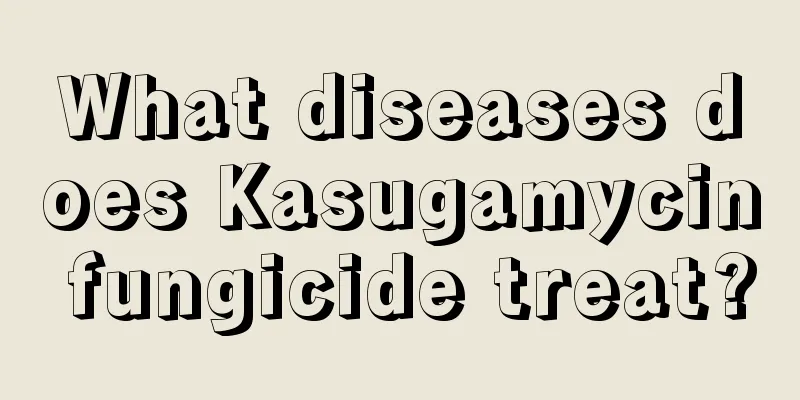What diseases does Kasugamycin fungicide treat?

|
Kasugamycin is a weakly alkaline antibiotic produced by Streptomyces, which has a good effect on eliminating many pathogens. However, for Kasugamycin fungicide , many people do not know what diseases it can treat? Let’s learn more about it below. What diseases does Kasugamycin fungicide treat? Kasugamycin, also known as Kasugamycin and Jiashoumi, is mainly used to prevent and control bacterial diseases. It has a broad bactericidal spectrum and can prevent and control more than 30 bacterial diseases such as bacterial wilt, soft rot, bacterial angular leaf spot, gummosis, rice blast, scab, leaf spot, and ulcer. It can also prevent and control various fungal diseases such as early blight, anthrax, and gray mold. It is especially effective against diseases such as rice blast, bacterial angular leaf spot of cucumber and watermelon, peach gummosis, pepper scab, and peach punch hole disease. Characteristics of Kasugamycin fungicide 1. Strong systemic permeability Kasugamycin has strong permeability and systemicity. After application, it can penetrate through the leaf surface to the back of the leaf and be transmitted to various parts of the plant, quickly killing the bacteria. 2. Non-toxic to humans and animals Kasugamycin is an antibiotic produced by microorganisms. It is non-toxic, residue-free and pollution-free to humans and animals. It fully complies with modern environmental protection requirements and is suitable for the production of green and organic agricultural products . 3. Good compatibility Kasugamycin has good compatibility with many fungicides such as tricyclazole, cymoxanil, bromothionil, sinomenine, jinggangmycin, and copper oxychloride, and its synergistic effect is very obvious. How to use Kasugamycin fungicide 1. To prevent and control rice blast, in the early stage of the disease, evenly spray 15 kg of water with 2% kasugamycin per mu each time, or 50 g of 20% kasugamycin mixed with 400-500 catties of water. 2. To prevent and treat bacterial angular leaf spot of cucumber and watermelon, use it in the early stage of the disease, and evenly spray 15 kg of water with 2% kasugamycin per acre each time. 3. To prevent and control potato ring rot, soak the seed potatoes in 2% liquid or 500-800 times diluted wettable powder for 15-30 minutes. 4. To prevent and control tomato leaf mold, gray mold, etc., you can spray 550-1000 times of 2% aqueous solution. 5. To prevent and control apple silver leaf disease, during the disease period, use 500 times diluted 2% kasugamycin wettable powder, and inject it through high pressure through trunk holes or through hanging injection, which has a good preventive effect. 6. To prevent and control citrus gummosis, scrape off the diseased part or cut the lesions vertically with a sharp knife, then apply 5-8 times diluted 4% kasugamycin wettable powder, and then wrap it with plastic film to prevent erosion by rain. That’s it |
<<: Will sunflowers bloom in winter? How to grow sunflowers in winter?
>>: What are the varieties of potted sunflowers and how far apart should they be planted?
Recommend
When and how to plant walnut trees
Walnut tree planting time When planting walnut tr...
When is the best time to sow broad beans in Henan?
Henan broad bean sowing time Broad bean, also kno...
How to plant and care for peony flowers (how to grow peony flowers vigorously at home)
To care for and manage peony flowers, you need to...
What to do if the leaves of green diamond flower turn yellow
1. Too much water If this is the reason why its l...
How to make dianthus bloom
1. Flower soil Using suitable soil for growing di...
What to do if the leaves of the money tree wilt
1. Rehydrate in time Reason: The leaves of the mo...
What is the best time to prune crabapple trees?
Regular pruning of crabapple trees can increase t...
The most practical fertilizer for orchids
1. What fertilizers can be used There are many fe...
How to propagate Drosera capensis and what to pay attention to
How to propagate the Cape Drosera Cape Drosera ca...
What to do if the roots of Huayuejin rot
Causes of root rot in Huayuejin The soil in the p...
How to grow Guangdong Dieffenbachia hydroponically
Water change requirements for hydroponic Dieffenb...
How to grow cactus in winter
1. Watering In winter, cacti need less watering a...
How to make flowers grow fast? Ten tricks to get it done
1. Onion water makes the flowers grow better and ...
Can Impatiens be placed indoors?
Is it poisonous? Impatiens is poisonous! The answ...
What are the differences between crabapple and sand apple?
Different families Crabapple is a plant of the Ro...









